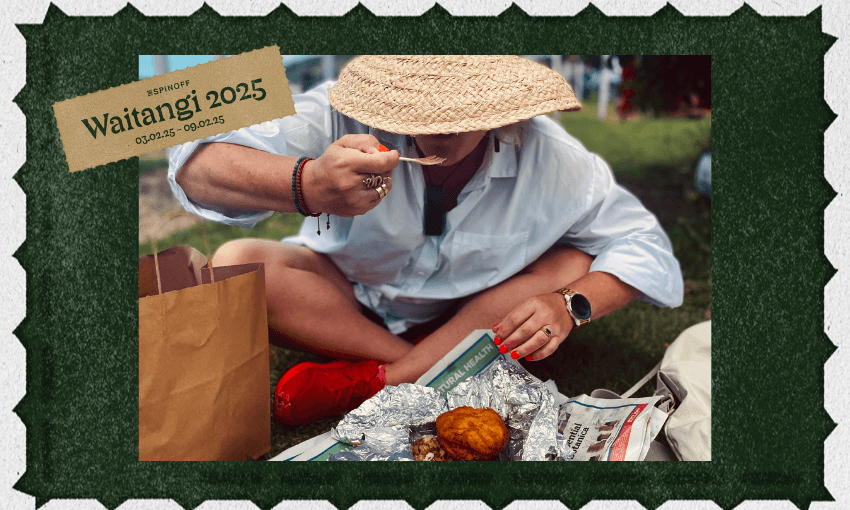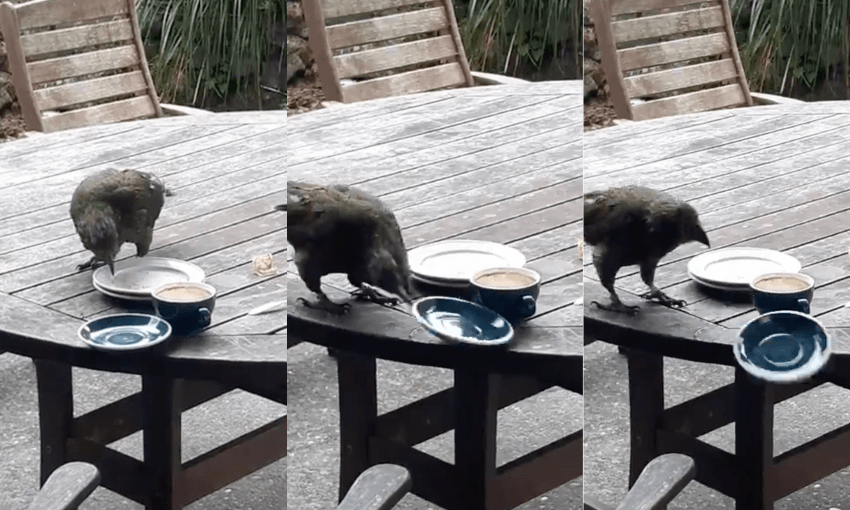People often claim they just want Waitangi Day to be a celebration. At Waitangi, away from the headlined political acrimony and the marae ātea, celebrating is what most people are doing.
The Spinoff Essay showcases the best essayists in Aotearoa, on topics big and small. Made possible by the generous support of our members.
On Monday, there are plenty of stools around the Ilovefoodies stall on which to perch to enjoy my heaped plate of prawns, mussels, fry bread and raw fish I have been looking forward to for a year. By Thursday, I am making do and sitting on the grass eating hāngī from a foil container that arrived wrapped in an old copy of the Northern Advocate. On both days, I wear white. Not coolly and casually like Kuīni Nga wai hono i te po did when she arrived at Waitangi, but perilously and foolishly. I lean forward and hope my steady hand would save me.
We arrive at Paihia on Sunday and walk to the markets at Waitangi Marae the next day. I was worried about missing out on the raw fish at the best food market I’ll visit all year. The crowds will swell over the week, and while I joke about going to Waitangi to stuff my face, I have a list of food I have to eat before I can leave. Fry bread, mussels, prawn, raw fish, mussel fritter, fry bread, hot donuts, pineapple and watermelon juice, a sausage in bread, fry bread and a taniwha burger.
The wharf in Paihia buzzes with tourists, boats and the odd chopper. The walk from the wharf to the bridge at Waitangi is only two kilometres long. Neither town is visible from the other. The bridge, which spans the estuary that flows out to Te Tii Bay, is the official boundary between Paihia and Waitangi, but I reckon you’re safe to say you have arrived at Waitangi once you’ve walked up the rise that juts out like a small bunion from the coastline, gone round the bend and can spot your first tino rangatiratanga or United Tribes flag fluttering from tents, buses and vans.
The demarcation between the two towns is geographically literal but often feels like more than that. Lanyard-wearing cruise ship passengers mill around Paihia, ready to hop on a boat to sight-see. For many, the Treaty is an artefact, an origin story and a historical curiosity. “Today is like their fourth of July,” one American tourist knowingly tells another on Waitangi Day as they lick Movenpick ice cream in the hot sun.
After three years, I think I’ve become good at spotting those for whom Paihia and Russell are the holding ground before immersing themselves in what’s just around the bend. Toitū te Tiriti and Kia kaha te reo Māori gear make it even more straightforward this year.
On Wednesday, we trek up to the Upper Treaty Grounds for the parliamentarians’ pōwhiri. The vehicles allowed beyond the road closure drive slowly, vigilant of the hundreds walking the roads. Before crossing the bridge, we spot Labour’s Barbara Edmonds and Camilla Belich leaving Waitangi Marae with cold drinks in hand. Shane Jones, who has described this year’s pōwhiri as a “circus”, is on home turf and is milling around near the bridge in shorts an hour or two before he’s due to be suited and booted up the hill. He jovially greets people and inspects one friend’s haul of Ngāpuhi merch approvingly. We pass a group of Green Party MPs engaged in a lively discussion about which waiata they will sing.
Last year, we went to the pōwhiri, and the air crackled after Ngāpuhi’s welcome. This year’s is quieter despite headlines about tension. A member of the Toitū te Tiriti group, which later protests the parliamentarians as they walk on, asks if we’d like to join them. I am trying to take semi-decent photos on my phone to send to The Spinoff team covering the pōwhiri, and the guy next to me and I agree that we have a good view and will stay put. A policewoman in mufti, prepared for a long, hot day with a Camelbak full of water, quietly keeps an eye on things, while a Māori warden wearing thick black tights says, “Excuse my back, whānau,” as she too quietly keeps an eye on things.
We move closer to the marae and stand just behind the women who will turn their backs on Tama Potaka, David Seymour and eventually, Jones. Standing stoically and silently, one woman is wearing red, black and white sunglasses that match her tino rangatiratanga earrings. The protesters are peaceful, incredibly stylish and boiling with quiet rage. They sing ‘Mana Motuhake’ softly at first, becoming louder as they move down to the marae ātea.
We leave the pōwhiri and head back down to Waitangi Marae, where I chase a mussel fritter with the hāngī eaten on the ground. On the way back, we watch the drivers of two golf carts carrying kuia and kaumātua towards the grounds engage in a light-hearted battle about who gets right of way. “I’ll sort you out later,” one of them says, tooting and waving as she watches the other claim victory.
On Thursday, we are up early to go to the dawn service. Away from headlights and floodlights, it is pitch black in parts on the walk up. I grip my husband’s hand and follow closely behind the others who have chosen to get up at 4am to observe the prayerful commemorations at Te Whare Rūnanga. We wisely buy cans of cold coffee rather than wait for hot coffee and stand until the grass is dry enough to sit down.
Former National Party minister Hekia Parata has likened the relationship between the Crown and Māori to marriage. Theologian and historian Alistair Reese described the Treaty last year as “a sacrificial union“. This year, Methodist leader Te Aroha Rountree cites Reese and cracks the reverential early-morning air with an accusation that the Crown is filing “for divorce” while Māori remain “blissfully unaware”. “That will be the headline,” I think to myself. It’s a great line and unusually political for the dawn service. We are all encouraged to sing ‘Whakaaria Mai’, a song I first heard while driving with Dad to school. He’s a fan of Prince Tui Teka, and his best-of cassette tape had a permanent residency in the glove box of the car. As a gift to one friend, who laughs outrageously at how often I cry when people sing together, I get teary. Shockingly, this continues during the national anthem, a dirge that usually stirs very little patriotism within me, given rare brightness by Jaedyn Randell this year.
The bagpiper tells an assembled crowd, strangely eager to make sure they’re as close as possible to him and the flagpole, that we must wait until precisely 6.47am before he can begin because of the television broadcast. In the interim, an elderly man begins trying to tell us about the flags. At first, it’s unclear whether he’s there officially as the piper’s warm-up act, but as his story about the Union Jack being named for Jacob and the Catholic architects of an unnamed Latter Day Saints church unfolds, I conclude he is an unscheduled guest lecturer. The piper begins at exactly 6.47am over the top of the man’s story, and we miss the end. He doesn’t seem to mind and starts up again once the piper has finished.
We end our time at Waitangi with a visit to the sports fields where vendors, food sellers and every kind of public good and service organisation set up stalls. You can chat about getting a smear test, working for Customs or watch the fire service demonstrate how not to put out an oil fire while eating half a watermelon topped with ice cream. There are karaoke tents and stages. I do laps to make sure I’ve covered off my list of food and we order fry bread with brisket and corn fritters. The woman manning the Eftpos machine apologises for yelling our order too loud when it’s ready. “People usually wander off,” she says. I try to look a little less eager for my food.
As a Pākehā, I told my husband that I felt like I was riding along as a passenger on his journey when we first went to Waitangi three years ago. He has gently chided me many times for that, saying it’s for everyone. While I no longer feel like I need my Māori husband’s swipe card to be there, our marriage is tested and strengthened each time we go. We slip in and out of habits and behaviour spotlighted by being on holiday together and observe change in each other in an environment where identity is loudly and boldly celebrated. We occasionally fight about things, both big and small. Sometimes, I walk far ahead of him, tension dividing us. We both get irritated at each other for not being where we said we’d be. Mostly, we eat, drink, laugh, swim and compete on daily step counts as we trek back and forth between Paihia and the Upper Treaty Grounds at Waitangi. We leave renewed and fulfilled.
When I debated whether to go the whole hog for my wedding and not just run away to the islands, a friend told me the best thing about doing it in front of people was that they were then heavily obliged to support you both throughout your marriage. If the relationship between the Crown and Māori is like a marriage, the annual celebrations and commemorations at Waitangi are most like a vow renewal. The relationship mightn’t be in the best shape. The toplines might be about tension. Sometimes harsh words are spoken, backs are turned, and struggles to assert independence and autonomy within a relationship are at odds with individual expectations and boundaries. Nonetheless, witnesses and guests front up to remind both parties that nothing worth having is straightforward, that conflict aversion isn’t helpful, and, most importantly, to celebrate further solidification, evolution, and the uniqueness of each party and the relationship.
At Waitangi, a day so ill defined by headlines breaks free of its time-bound shackles and reveals itself as a week-long celebration and renewal. The “celebration” frequently demanded by those who feel robbed of having a “national” day is right there for the taking, just around the bend.

